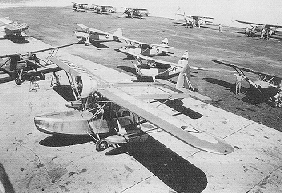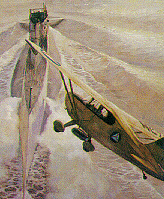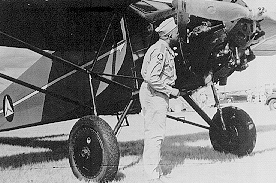 |
|||||
| Home | Research | For Teachers | HISTORY Level 1 Level 2 Level 3 |
PRINCIPLES Level 1 Level 2 Level 3 |
CAREER Level 1 Level 2 Level 3 |
| Gallery | Hot Links | What's New! | |||
| Web Administration and Tools | |||||
 |
|||||
| Home | Research | For Teachers | HISTORY Level 1 Level 2 Level 3 |
PRINCIPLES Level 1 Level 2 Level 3 |
CAREER Level 1 Level 2 Level 3 |
| Gallery | Hot Links | What's New! | |||
| Web Administration and Tools | |||||
![]()
Throughout Civil Air Patrol's (CAP) history, there has been many heroes. One of the greatest was Capt. Johnny Haggin. Haggin's valor as the pilot of the famous submarine sinking flight, off the coast of New jersey in 1942, is well-documented in many books written by and about the CAP, but little else has been published about him.
John Ben Ali Haggin was born of Irish-Arabian descent on August 19, 1916, in New York City. he was described as “having always been air-minded.”
He began his flying career at 15 in 1932 and recorded his first solo flight August 13th of that same year. the flight was made in a Fleet, with a 100-horsepower Kinner engine.
In March 1938, Haggin purchased his first airplane a Stinson, tail number NC-16116.
He continued gaining experience in other types of aircraft as well, including Fairchilds, Wacos, and Belancas. By the time he sold his Stinson in September 1939, Haggin had accumulated 424 hours of flight time.
Meanwhile Haggin worked to increase his knowledge and experience in the aviation business world. In 1934 he worked for the Peel Glider-Boat Company and was in charge of sales demonstrations. In 1935, he served as the assistant operations manager for North Beach Air Service Inc. The airport they operated out of is known now as LaGuardia.
From 1936 to 1938 he worked as an assistant to the president of Seversky Aircraft Co., as well as sales and other work for a variety of aviation firms including Hayes Aircraft Accessories Corp. His step father, Felix William Zelcer, was president Hayes. By 1941, Haggin was made a vice president at Hayes.
When Pearl Harbor was bombed, Haggin resigned from Hayes and applied for enlistment in the Army Air Corps as an aviation cadet. His application was denied solely on his below-minimum-standard eyesight.
Though deeply disappointed, he turned like thousands of other airmen who couldn't qualify for active duty to the newly formed CAP. When the green light was given by the Army Air Corps to set up three experimental bases for CAP's antisubmarine patrol, Haggin volunteered and was assigned to Patrol Force 1 in Atlantic City, N.J.
Haggin and his step father arrived in Atlantic City on March 26, 1942, shortly after operations out of the base had begun. Not only did their arrival bring two more desperately needed pilots, but also the addition of a rare amphibious aircraft Bill Zelcer's Grumman Widgeon, tail number N28674.
 Grumman Widgeon in CAP colors at Patrol Force 1. |
|---|
Zelcer remained until the end of May and then returned home to run his business. Haggin remained with the Widgeon which was left in his care. He quickly became operations officer and was second in command of the base.
In all, Haggin was credited with 613 hours of pilot time and 75 hours of observer time on often monotonous, but very dangerous overwater flights. On one particular day, because “only two ships were available for patrol,” according to his log books, Haggin flew three separate patrols for a total of 10 hours and 20 minutes.
His fame in CAP history is for his flight with Maj. Wynant Farr, the base commander, on July 11, 1942. A patrol plane out of Atlantic City spotted a submarine cruising near the surface about 25 miles east of Absecon. The plane was running out of fuel and had to return. Farr grabbed Haggin, and the two took off in the Widgeon.
Upon arriving at the site, a line of oil globs was spotted rising to the surface and then the long dark shape became visible gliding below. Because the U-boat was below periscope depth, Haggin and Farr decided to trail it; hoping she would rise closer to the surface and give them a better shot.
For more than four hours they trailed it, circling and zigzagging; patiently waiting. Just as they were running low on fuel and would have to turn back, the U-boat came up toward periscope depth for a look around. It would prove a fatal mistake.
Haggin swooped the yellow twin-engine amphibian behind the enemy and Farr let loose the first of two 325-pound aerial depth charges; splashing into the water just a few feet off the submarine's bow.
 |
| The attack! |
|---|
The resulting explosion rocked the CAP fliers in the air and boiled the sea. Amidst a geyser of water and oil, Farr thought he saw, for a fleeting moment, the nose of the U-boat break the surface and slide back below. Dropping their second and final charge in the growing oil slick, Haggin and Farr observed shattered deck planking rising to the surface in the bubbling oil.
Because of tight security, the story of his heroic achievement did not become public knowledge until almost after the war. many of the personnel at the patrol base itself were unaware until as much as two years later that they had been responsible for the death of one of the steel gray monsters they had loathed so much. By the time the story got out, Haggin had already left CAP.
Going into the summer of 1943, it was growing apparent that the U-boat activity on the East Coat was almost nonexistent and CAP coastal patrols would soon become obsolete. Many of the younger flyers, Haggin among them, sought transfer to the Air Transport Service or other branches. With the relaxing of certain entrance requirements, Haggin was appointed as a service pilot in Air Transport Command and received a commission as a 1st lieutenant in July 1943.
 |
| A CAP Minuteman. |
|---|
During his time in the Air transport Service, Haggin flew a variety of airplanes including the AT-2, B17, B-24, B-25, B-26, C-45, C-46, C-47, C-49, C-54, OA-10, and the OA-14. His flying skills and his hours over water with CAP made him a prime candidate for search and rescue.
In April 1944, he was assigned to sea rescue operations of the Caribbean Division, Air Transport Command. He flew OA-10 aircraft out of Morrison Field, West Palm Beach, Florida. It was here that Haggin was once again a hero.
On March 23, 1945, a U.S. Navy Miami Avenger crashed at sea during a training flight with one officer and two enlisted people on board.
Within minutes after notification, Haggin had his crew assembled and was airborne and en route to the reported position. He quickly established contact with a destroyer and discovered the first reported position wrong.
Swift course corrections had him over the target area, 35 miles east of Fort Lauderdale, within 30 minutes. The life raft was spotted and despite the waves and swells of the open sea a skillful landing and takeoff was executed. The rescued crew was on the way back to home base only 55 minutes after hitting the water.
For his action that day, Haggin was nominated for the Air Medal by his superiors. The recommendation was unfortunately denied; however, he was awarded the Army Commendation by Brig. Gen. H.S. Hansell Jr. nearly a year later. Haggin left active duty in January 1946.
In April 1948, Haggin finally received an Air Medal. By way of General Orders, 12-17, 824 aircrew members of the 21 CAP antisubmarine coastal patrol bases were awarded the Air Medal. The orders were officiated by Gen. Carl A. Spaatz, chief of staff of the new U.S. Air Force. The accompanying certificates were signed by President Harry S. Truman.
Haggin was a CAP double American hero.
By Lt. Col. Gregory F. Weidenfeld, CAP national Historian, “John Ben Ali Haggin: A CAP Hero of the highest order”; Civil Air Patrol News, Vol. 27, No. 11, November 1995.
Also see: William B. Mellor, Sank Same; (New York: Howell, Soskin, Publishers), 1944, p. 224.
Send all comments to ![]() aeromaster@eng.fiu.edu
aeromaster@eng.fiu.edu
© 1995-98 ALLSTAR Network. All rights reserved worldwide.
Updated: 17 February, 1999